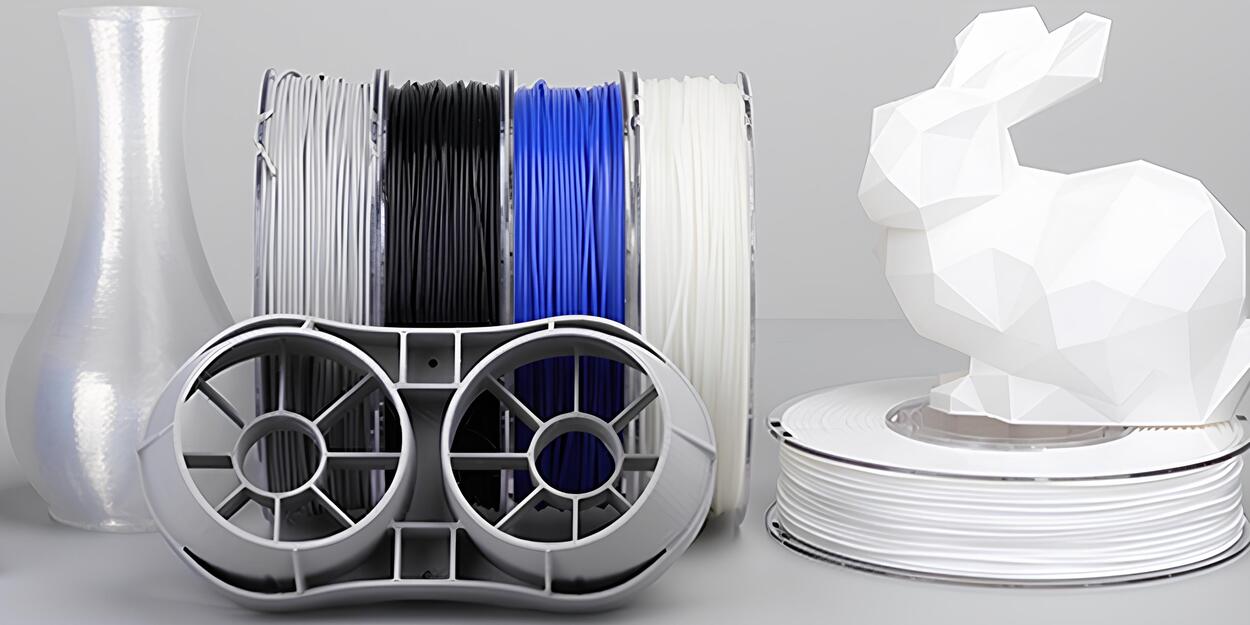Banner Image Courtesy of Kexcelled
What Is PLA Filament?
Polylactic Acid (PLA) filament is one of the most popular thermoplastics used in FDM 3D printing. Derived from renewable resources such as corn starch or sugarcane, PLA boasts a low melting temperature and excellent ease of use. As a bio-based plastic, PLA offers a more sustainable alternative to petroleum-derived filaments, making it a top choice for all makers.
Unlike some engineering plastics, PLA emits minimal odor during printing and does not require a heated build plate, simplifying printer setup. It's wide availability in a rainbow of colors, from translucent to neon, so that designers can find the perfect variant for prototypes, art pieces, and functional models.
Key Material Properties
Glass Transition Temperature (Tg): 55 – 60°C. A relatively low Tg makes PLA easy to print but limits its use in high-temperature environments.
Melting Temperature: 150 – 160°C. PLA flows readily at lower temperatures, enabling fine detail and reduced stringing when tuned properly.
Tensile Strength: ~50MPa. Good tensile strength compared to other hobbyist filaments, supporting moderately load-bearing parts.
Elongation at Break: ~9%. PLA is more brittle than ABS or PETG. Parts can crack under impact if not designed with sufficient thickness or flexibility.
Density: 1.24g/cm³. Slightly heavier than water, PLA provides solid, stable prints but tends to sink rather than float.
Surface Finish: Glossy or matte (depending on brand). Smooth surfaces and crisp details make PLA ideal for display models and ornamental pieces.
Biodegradability: Industrial composting only. Although marketed as biodegradable, PLA requires industrial composting facilities; home composting will not fully break it down.
Pros and Cons of 3D Printing PLA Filament
|
Pros |
Cons |
|
Ease of printing (no heated bed required, minimal odor) |
Low heat resistance (prone to deform above ~50 °C) |
|
Excellent dimensional accuracy and fine-detail capability |
Brittleness (limited impact resistance, can crack under load) |
|
Eco-friendly origins (made from renewable plant sources) |
Poor UV resistance (can become brittle and discolor outdoors) |
|
Wide selection of colors and specialty blends |
Limited mechanical use (not ideal for high-stress parts) |
|
Cost-effective for prototyping and educational use |
Biodegradability requires industrial composting (not home) |
Recommended Printer Settings
|
Setting |
Recommended Range |
Notes |
|
Nozzle Temperature |
190 – 210 °C |
Lower end for fine detail; higher end for faster printing. |
|
Bed Temperature |
0 – 60 °C |
0 °C works for build-tak; 60 °C improves first-layer adhesion. |
|
Print Speed |
40 – 60 mm/s |
Slower speeds enhance accuracy; adjust upward for drafts. |
|
Layer Height |
0.1 – 0.3 mm |
0.2 mm is a good balance of speed vs. detail. |
|
Retraction Distance |
1 – 6 mm |
Bowden setups need more; direct drives need less. |
|
Retraction Speed |
25 – 60 mm/s |
Tune to minimize stringing without causing clogging. |
|
Cooling Fan speed |
50 – 100 % |
PLA benefits from active cooling; 100 % for bridges and overhangs. |
|
Build Plate Surface |
Glass, blue tape, PEI |
Ensure level bed and clean surface for consistent adhesion. |
Top Applications for PLA 3D Prints
Prototyping & Concept Models
Quick, low-cost iterations to visualize form and fit before moving to stronger materials.
Educational Projects
Safe for classroom environments due to low odor and minimal fumes.
Artistic & Decorative Objects
Vases, figurines, jewelry, and cosplay props benefit from PLA’s vivid colors and textures.
Architectural Mock-ups
Scale models of buildings and landscapes where fine detail is essential.
Low-Stress Functional Parts
Enclosures, brackets, and jigs that won’t face high heat or mechanical load.
Support Structures for Resin Prints
PLA dissolvable blends can create support scaffolding for SLA prints, simplifying post-processing.
Try Hi3DP FDM 3D Printing Service
Looking to skip the calibration and dial-in work?
Hi3DP’s FDM 3D printing service specializes in PLA and other engineering-grade materials. Here’s why thousands of customers trust Hi3DP:
Instant Quotes & Rapid Turnaround: Upload your STL, choose PLA, and get pricing within minutes—shipped in as little as 2 business days.
Quality Assurance: Parts undergo dimensional inspection and strength testing to meet your specifications.
Custom Finishes & Assembly: Post-processing options include sanding, painting, and chemical smoothing. Assembly and kitting services are available for multi-part projects.
Global Shipping & Support: Whether you’re in North America, Europe, or Asia, we deliver reliable quality worldwide.
FAQs
Q: Is PLA filament food safe?
A: PLA itself is derived from plant sources, but most filaments contain colorants and additives that are not food-grade. If you need food-safe prints, seek certified PLA and use a stainless-steel nozzle, plus apply a food-safe sealant post-print.
Q: How do I prevent PLA prints from warping?
A: Use a clean, level bed, apply glue stick or blue painter’s tape, and print with a brim when printing large flat parts. Maintaining ambient temperature without drafts also helps.
Q: Can I glue or paint PLA parts?
A: Yes. PLA bonds well with cyanoacrylate (super glue) and epoxy. Acrylic paints adhere nicely after a light sanding and application of a primer.
Q: How should I store PLA filament?
A: PLA is hygroscopic. Store spools in airtight containers with desiccant packs or in resealable vacuum bags to prevent moisture absorption and ensure consistent print quality.
Q: What alternatives exist if I need stronger material?
A: For higher heat resistance or mechanical strength, consider ABS, PETG, Nylon, or engineered composites like carbon-fiber PLA blends.














